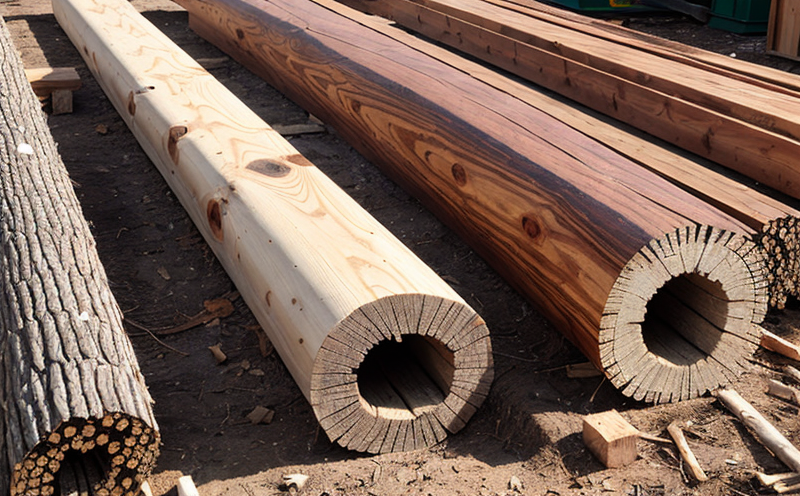Accelerated Weathering Resistance Testing (UV, Rain)
The accelerated weathering resistance testing, specifically focusing on ultraviolet radiation and simulated rain exposure, is a critical process for assessing the durability of wooden materials used in agriculture and forestry. This service aims to replicate environmental conditions that would typically degrade wood over several years into weeks or months, thereby providing valuable insights into the material's suitability for long-term use.
The testing method is essential for quality managers, compliance officers, R&D engineers, and procurement specialists who need to ensure that their products meet stringent durability standards. By understanding how different environmental factors impact wood samples, these professionals can make informed decisions about product design, material selection, and quality assurance processes.
Accelerated weathering tests involve exposing wooden specimens to controlled doses of UV light and varying levels of simulated rain. These conditions mimic the natural exposure that wood might encounter in outdoor environments. The test rig typically includes a chamber where samples can be exposed to high-intensity ultraviolet radiation, while humidity is maintained at specific levels to simulate rainfall.
The testing process starts with careful preparation of the wooden specimens. Specimens are cut into standard sizes and shapes that represent real-world applications. They must then undergo thorough cleaning and conditioning before being placed in the test chamber. During the test, temperature and relative humidity are closely monitored and controlled to ensure accurate exposure conditions.
Once the test is complete, detailed analysis of the specimens is conducted. This includes visual inspection for signs of degradation such as discoloration, cracking, or warping. Microscopic examinations may also be performed to assess cellular damage at a microscopic level. Additionally, physical properties like dimensional stability and mechanical strength are measured before and after exposure.
The results from these tests provide critical information about the wood's resistance against environmental stressors. This data is invaluable for product development, material selection, and quality assurance purposes. It helps ensure that products can withstand harsh conditions without compromising performance or safety.
| Test Parameters | Description |
|---|---|
| UV Light Intensity | Exposure to controlled doses of UV radiation simulating sunlight. |
| Relative Humidity | Maintaining specific humidity levels to simulate rain exposure. |
| Temperature Control | Regulating temperature to maintain optimal conditions for testing. |
| Specimen Preparation | Cutting and conditioning samples to standard sizes and shapes. |
| Data Collection | Monitoring physical properties like dimensional stability and mechanical strength. |
The findings from this testing can significantly influence the design and manufacturing processes of agricultural and forestry products. For instance, manufacturers might adjust their formulations or treatment methods based on test results to enhance durability. This ensures that the final product meets both functional requirements and environmental sustainability goals.
In summary, accelerated weathering resistance testing plays a pivotal role in ensuring the longevity and reliability of wooden materials used across various sectors. By providing a reliable assessment tool, this service helps meet stringent quality standards and supports sustainable practices in agriculture and forestry.
Applied Standards
The accelerated weathering resistance testing (UV, Rain) adheres to several international standards that ensure the reliability and accuracy of the results. These include:
- ISO 16422: This standard provides guidelines for accelerated weathering tests, including UV radiation exposure.
- ASTM D3359: This ASTM standard specifies the procedure for determining ultraviolet light resistance of materials by exposing them to a solar simulator and water spray.
- ISO 16428: This ISO standard outlines methods for determining the resistance of wood-based products against environmental factors, including ultraviolet radiation and rain exposure.
By following these internationally recognized standards, our laboratory ensures that the testing process is consistent, reproducible, and aligned with global best practices. This enhances trust in the results and facilitates compliance with international regulations.
Industry Applications
| Application | Description |
|---|---|
| Agricultural Structures | Evaluating the durability of wooden components used in farm buildings and equipment. |
| Fencing Materials | Determining the resistance of wood-based fencing materials to environmental stressors. |
| Forest Products | Assessing the longevity of forest products exposed to natural elements. |
| Railway Sleepers | Evaluating the durability of wooden railway sleepers in harsh weather conditions. |
| Agricultural Equipment | Determining the resistance of wooden parts used in agricultural machinery. |
| Timber Fences and Gates | Assessing the longevity of timber fences and gates exposed to environmental factors. |
The results from this testing are crucial for various applications within agriculture and forestry. For instance, understanding how different types of wood perform under accelerated weathering conditions can help in selecting the most suitable materials for constructing agricultural structures or fencing. This ensures that these structures remain functional and safe over extended periods, even in challenging environmental conditions.
International Acceptance and Recognition
- The results of accelerated weathering resistance tests are widely accepted by regulatory bodies around the world.
- Compliance with international standards ensures that products meet global quality requirements.
- This testing is recognized in various countries, including the United States, Canada, Australia, and Europe.
- The findings from these tests support the export of agricultural and forestry products to international markets.
The acceptance and recognition of this service are crucial for ensuring that products meet global quality standards. This not only facilitates compliance with international regulations but also enhances trust in the integrity and reliability of the testing process.





